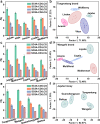A facile way to construct sensor array library via supramolecular chemistry for discriminating complex systems
- PMID: 35879312
- PMCID: PMC9314354
- DOI: 10.1038/s41467-022-31986-x
A facile way to construct sensor array library via supramolecular chemistry for discriminating complex systems
Abstract
Differential sensing, which discriminates analytes via pattern recognition by sensor arrays, plays an important role in our understanding of many chemical and biological systems. However, it remains challenging to develop new methods to build a sensor unit library without incurring a high workload of synthesis. Herein, we propose a supramolecular approach to construct a sensor unit library by taking full advantage of recognition and assembly. Ten sensor arrays are developed by replacing the building block combinations, adjusting the ratio between system components, and changing the environment. Using proteins as model analytes, we examine the discriminative abilities of these supramolecular sensor arrays. Then the practical applicability for discriminating complex analytes is further demonstrated using honey as an example. This sensor array construction strategy is simple, tunable, and capable of developing many sensor units with as few syntheses as possible.
© 2022. The Author(s).
Conflict of interest statement
The authors declare no competing interests.
Figures









Similar articles
-
Adaptive Supramolecular Networks: Emergent Sensing from Complex Systems.Angew Chem Int Ed Engl. 2023 Nov 6;62(45):e202312407. doi: 10.1002/anie.202312407. Epub 2023 Sep 27. Angew Chem Int Ed Engl. 2023. PMID: 37699200
-
Recent Progress in Sensor Arrays: From Construction Principles of Sensing Elements to Applications.ACS Sens. 2023 Mar 24;8(3):994-1016. doi: 10.1021/acssensors.2c02596. Epub 2023 Feb 27. ACS Sens. 2023. PMID: 36848439 Review.
-
Supramolecular chemistry approach to the design of a high-resolution sensor array for multianion detection in water.J Am Chem Soc. 2007 Jun 20;129(24):7538-44. doi: 10.1021/ja0704784. Epub 2007 May 27. J Am Chem Soc. 2007. PMID: 17530846
-
Combinatorial Library-Screened Array for Rapid Clinical Sperm Quality Assessment.Anal Chem. 2025 Feb 18;97(6):3748-3755. doi: 10.1021/acs.analchem.4c06952. Epub 2025 Feb 8. Anal Chem. 2025. PMID: 39921623
-
Array-Based Discriminative Optical Biosensors for Identifying Multiple Proteins in Aqueous Solution and Biofluids.Front Chem. 2020 Nov 4;8:572234. doi: 10.3389/fchem.2020.572234. eCollection 2020. Front Chem. 2020. PMID: 33330361 Free PMC article. Review.
Cited by
-
Dual hypoxia-responsive supramolecular complex for cancer target therapy.Nat Commun. 2023 Sep 13;14(1):5634. doi: 10.1038/s41467-023-41388-2. Nat Commun. 2023. PMID: 37704601 Free PMC article.
-
Nanotechnology improves the detection of bacteria: Recent advances and future perspectives.Heliyon. 2024 May 28;10(11):e32020. doi: 10.1016/j.heliyon.2024.e32020. eCollection 2024 Jun 15. Heliyon. 2024. PMID: 38868076 Free PMC article. Review.
-
Mixed host co-assembled systems for broad-scope analyte sensing.Chem Sci. 2024 Jul 1;15(31):12388-12397. doi: 10.1039/d4sc02788d. eCollection 2024 Aug 7. Chem Sci. 2024. PMID: 39118638 Free PMC article.
-
Calixarene-Based Supramolecular Sensor Array for Pesticide Discrimination.Sensors (Basel). 2024 Jun 8;24(12):3743. doi: 10.3390/s24123743. Sensors (Basel). 2024. PMID: 38931527 Free PMC article.
-
Supramolecular discrimination and diagnosis-guided treatment of intracellular bacteria.Nat Commun. 2025 Jan 25;16(1):1016. doi: 10.1038/s41467-025-56308-9. Nat Commun. 2025. PMID: 39863571 Free PMC article.
References
Publication types
MeSH terms
Substances
LinkOut - more resources
Full Text Sources

